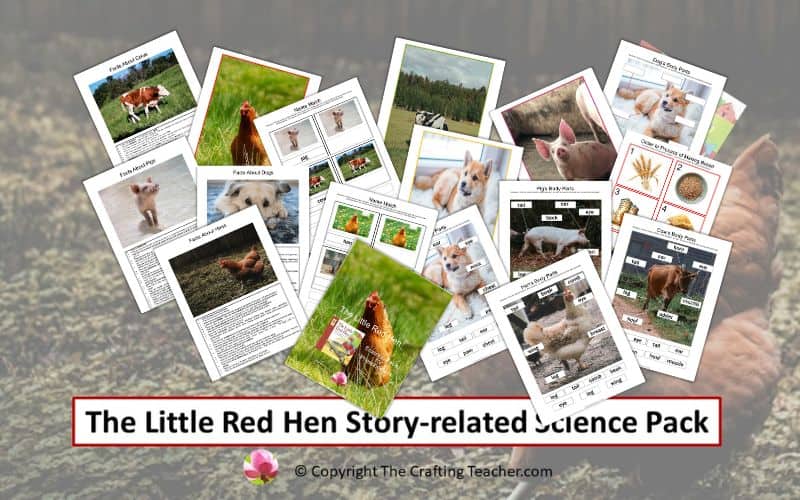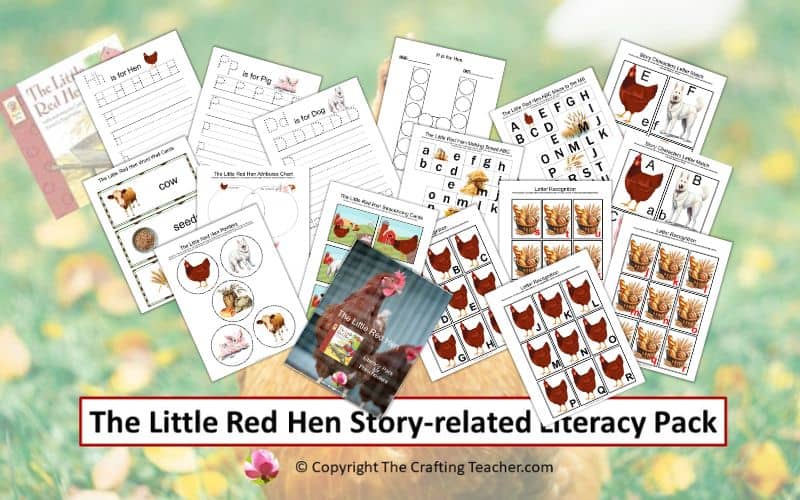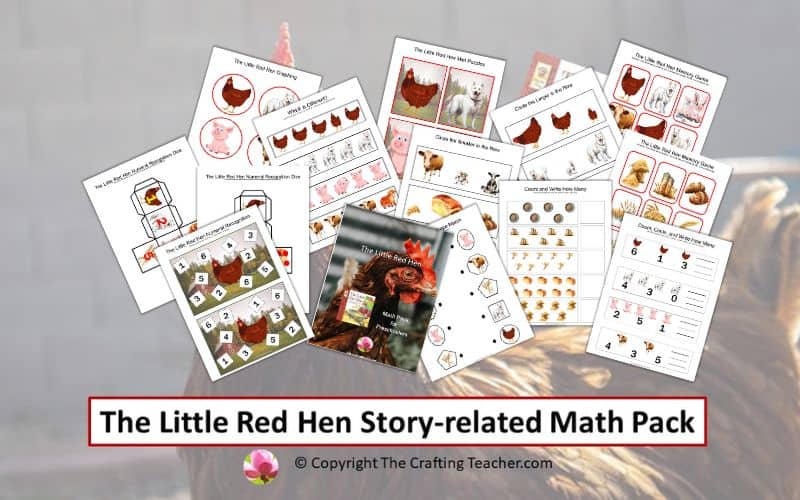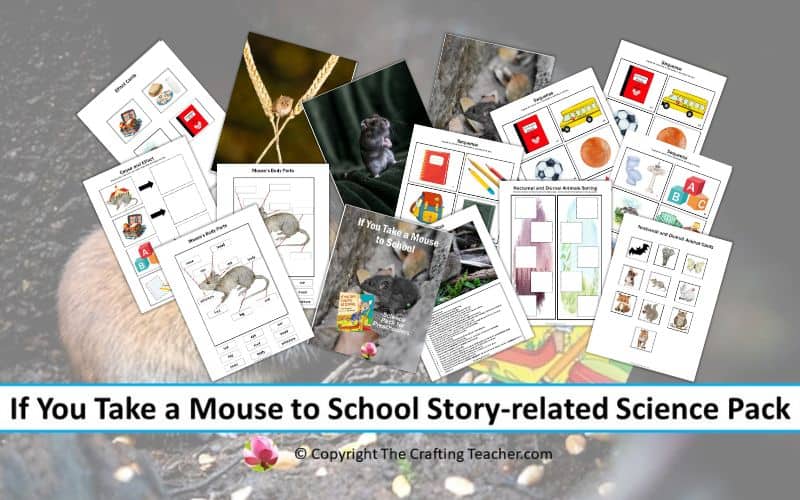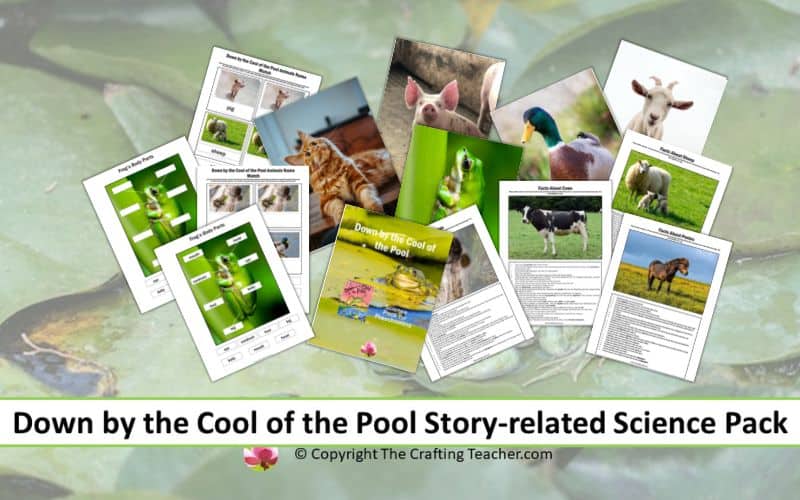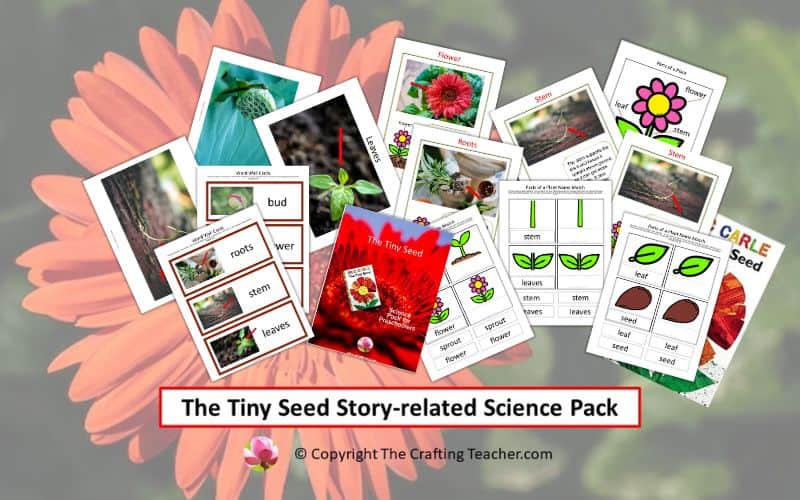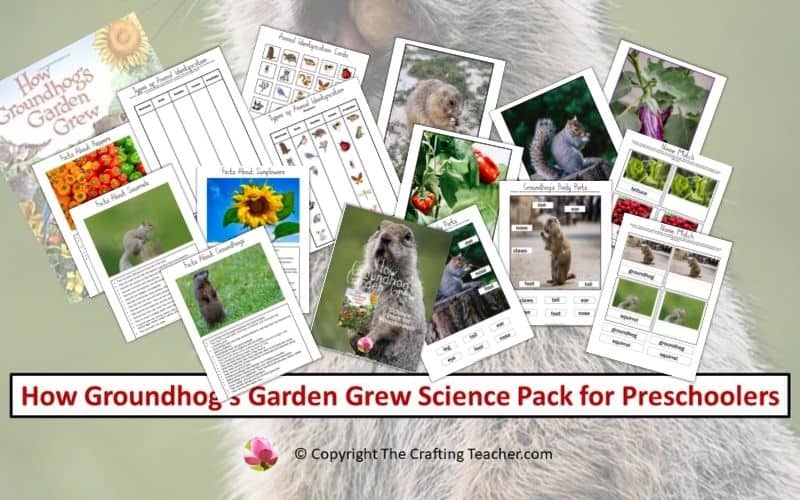The Little Red Hen Story-related Science Pack for Preschoolers
Affiliate Disclosure: “This post contains affiliate links, which means I receive a small commission, at no extra cost to you, if you make a purchase using those links.”
Using storybooks to teach science to preschoolers is an excellent way to help them discover the world around them and learn why and how things happen. This FREE 23-page The Little Red Hen Story-related Science Pack will help you teach them about the animals in the story and the bread-making process. You can download it at the end of this post.
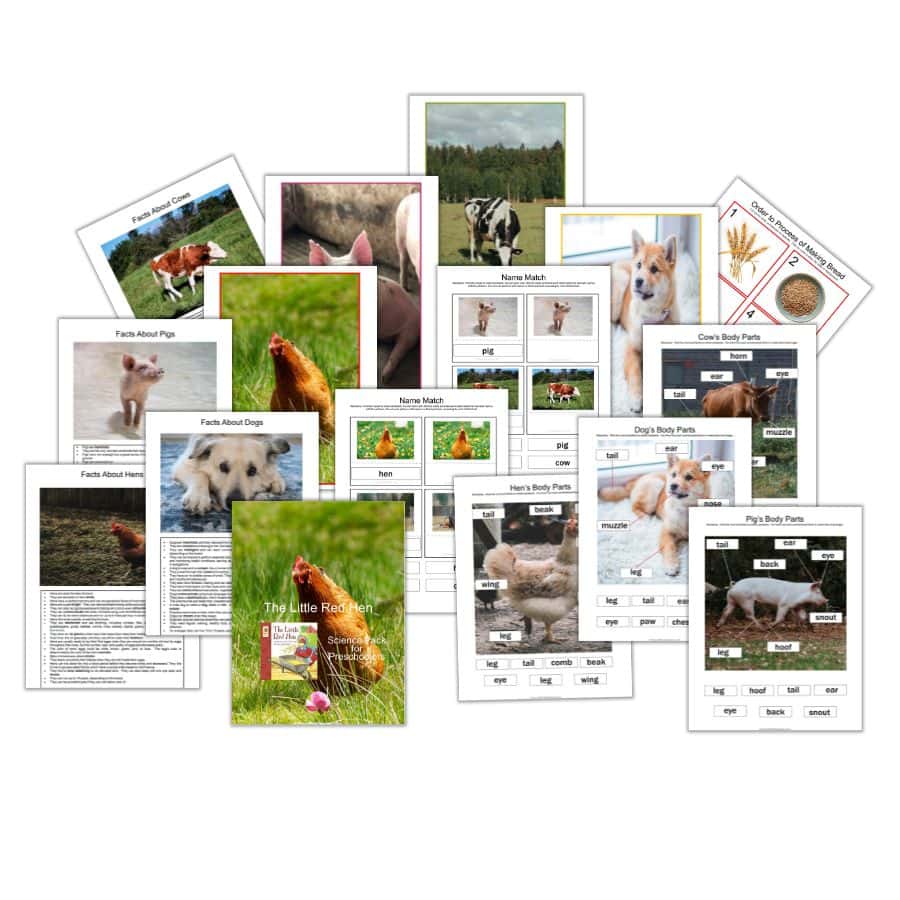
The Little Red Hen is a classic story with predictable text about a little red hen who finds wheat seeds and wants to plant them to make bread. However, she has to do it independently because her farm animal friends refuse to help her.
Benefits of Teaching Science to Preschoolers
Children are always trying to make sense of what they perceive with their senses, asking tons of questions to find the “why” about things and investigating how things work. We must take advantage of their natural curiosity and help them develop their scientific thinking.
Taking the time to introduce science to young children in a fun and interactive way gives them many benefits. Some of them are:
- Help them use their interest in exploring and experimenting to establish a positive connection to science.
- Encourage them to love science and stay interested for many years, if not throughout their lives.
- Stimulate their scientific thinking and help them make sense of the world around them, why things happen, and how they work.
- Extend their vocabulary by promoting language development using scientific words, communication, teamwork and cooperation, reasoning, and problem-solving skills.
You can use science to teach every domain because it easily relates to literacy, math, and art. Therefore, always encourage your children to ask questions, observe different natural phenomena, experiment, and explore. Most importantly, give them plenty of opportunities to do just that by offering fun, interactive, and hands-on experiences.
The Little Red Hen Story-related Science Pack
This storybook can be used as a base for many science activities. Below are some I like to use.
Explain Facts About the Animals in the Story
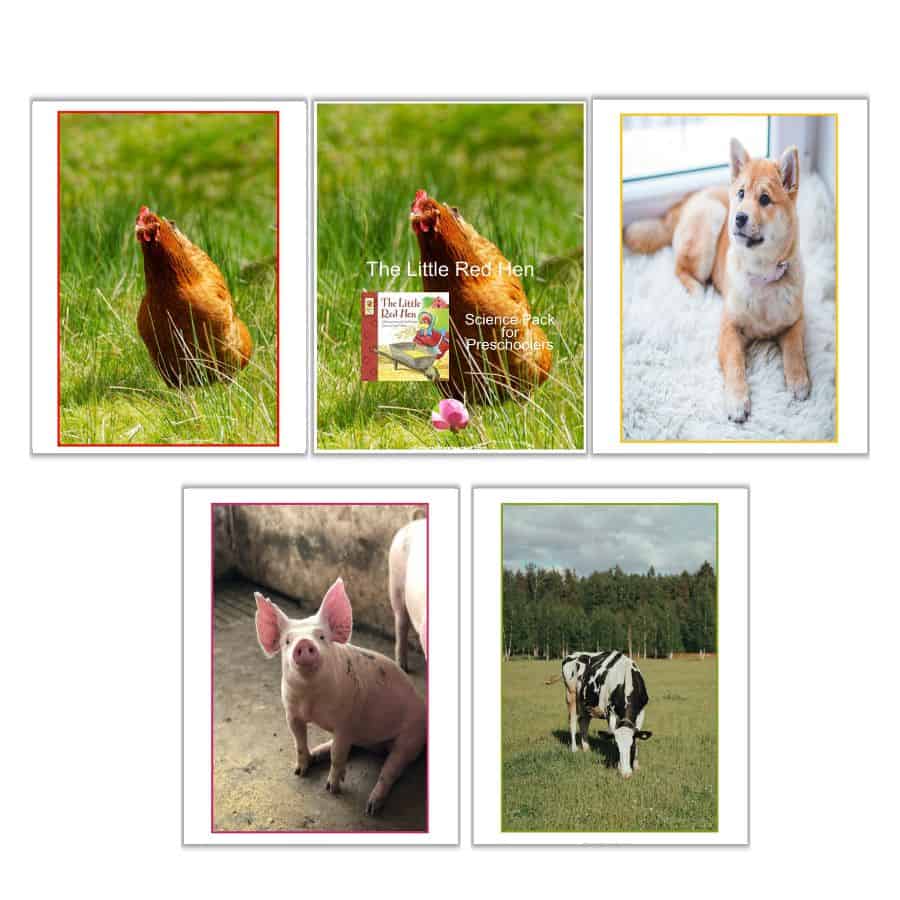
Introduce one animal at a time, showing them a toy or actual picture. Ask them if they know which animal is and what they know about it. Write everything they say on chart paper to review it later. Discuss some of the characteristics of each animal to help them understand the different ones and distinguish between them. You can also show them videos of each animal to support the facts you are teaching about each one.
Facts About Hens
- Hens are adult female chickens.
- They are domestic or farm birds.
- Hens have a perfect memory and can recognize the faces of more than 100 other chickens.
- Hens are super bright. They can demonstrate thinking skills and solve complex problems.
- They can also recognize people and distinguish colors, even ultraviolet light.
- They can communicate with other chickens using over 30 different vocalizations.
- They can fly for short distances and run up to 9 miles per hour in short bursts.
- Hens like to be outside, scratching for food.
- They are omnivores and eat anything, including crickets, flies, spiders, ticks, caterpillars, grasshoppers, grubs, beetles, worms, mice, snakes, lizards, grains, some plant leaves, grass, and clover.
- They have an oil gland on their back that helps them keep their feathers waterproof.
- Over time, the oil gets stale, and they use dirt to clean their feathers.
- Hens are usually ready to lay their first eggs when they are around six months old and continue to do so throughout their lives, but the number, size, and quality of eggs laid decrease yearly.
- The color of hens’ eggs could be white, brown, green, pink, or blue. The egg’s color is determined by the color of the hen’s earlobe.
- Baby chickens are called chicks.
- They teach sounds to their babies when they are still inside their eggs.
- Hens can only live alone for a short period before they become lonely and depressed. They like to live in groups called flocks, which have a social order based on dominance.
- They like to sleep balancing on an elevated stick. They can also sleep with one eye open and dream.
- They can live up to 10 years, depending on the breed.
- They can be excellent pets if they are well taken care of.
Facts About Dogs
- Dogs are mammals, and they descend from an extinct wolf.
- They are intelligent and can learn commands, tricks, and up to 250 words and gestures, depending on the breed.
- They can be trained to perform essential jobs such as helping people with disabilities, diagnosing and monitoring health conditions, serving as protectors and lifeguards, and helping with police investigations.
- A dog’s nose print is unique, like a human’s fingerprints.
- They sweat through their paws and panting.
- They have an incredible sense of smell. They can follow scent trails and breathe with their noses and mouths simultaneously.
- They also have fantastic hearing and can detect high-pitched noises.
- They have three layers on their eyes and can only see some colors.
- They are omnivores and eat plants, vegetables, fruits, and meat.
- Dogs communicate using body language to express their feelings and have facial expressions.
- They have a dominant paw, which means they can be correct or left-pawed.
- The Greyhounds are faster than cheetahs and can run 45 miles per hour for over 7 miles.
- A male dog is called a dog, stud, or sire. A female is called bitch, and a baby dog is called a puppy.
- Puppies cannot see or hear when they are just born.
- Dogs can dream when they sleep.
- Dogs are popular pets because they are playful, friendly, and loyal.
- They need regular walking, healthy food, a clean, cozy place to sleep, and lots of love and affection.
- On average, they can live 10 to 13 years, equivalent to 60 to 74 years in a human.
Facts About Pigs
- Pigs are mammals.
- They are the only animals worldwide that have successfully donated organs to humans.
- Pigs have low eyesight but a great sense of smell and a powerful ability to sense food under the ground.
- Pigs can swim and run.
- Domestic pigs can run up to 17 kilometers per hour, while wild pigs can run up to 50 kilometers per hour for a short distance. They run in a zigzag way.
- Pigs are among the most intelligent creatures on the planet, even more than dogs. They can perform many tasks, use tools, learn basic commands and tricks, and even play video games.
- They also have excellent memory, get familiar with their names, and come to you when called.
- Pigs are omnivores who love to eat various foods, such as meat, grasses, flowers, leaves, fish, and roots.
- A fully-grown pig can weigh up to 700 pounds.
- They don’t sweat and must use mud to regulate their body temperature.
- They are among the cleanest animals and never go to the bathroom near their food and sleeping area.
- Each pig has individual behavioral traits that form their personality.
- They like to stay near each other, playing and sleeping together, often touching each other’s noses.
- Pigs are social animals that prefer to live in organized groups with a strict hierarchy established through fighting. They also form strong bonds that can last their entire lives.
- A male pig is called a board, a female is called a sow, and a baby is called a piglet.
- They can communicate using more than 20 vocalizations to convey different messages.
- Piglets can recognize their mother’s voice at two weeks old.
- Mother pigs sing to their babies while nursing.
- They can be great pets due to their friendly, caring, social, playful, and sensitive nature.
Facts About Cows
- Cows are mammals. They are also called cattle.
- They are intelligent, have excellent memories, and can remember the faces and names of other cows.
- They have excellent hearing and sense of smell.
- They do not have front upper teeth; therefore, they cannot bite.
- Cows have 300-degree vision and can see all directions, but they don’t see red or green colors.
- They are herbivores and only eat grass, hay, and other vegetation.
- They have one stomach with four chambers that help them extract the nutrients from their food by regurgitating what they ate to chew it again, but they cannot vomit.
- Cows can be all white, all black, brown, yellowish, or orange or have spots unique to each cow.
- Not all breeds of cow have horns.
- The milk we drink comes from cows. It is lower in fat and cholesterol and rich in protein, calcium, and vitamins A and D.
- Cow’s milk is used to make different dairy products like butter, cheese, and yogurt.
- Humans also eat meat and use their skin (leather) for different purposes, such as covering furniture and making belts and purses.
- Cows are good swimmers; they can jump up to 5 feet high, run up to 35 miles per hour, and go upstairs, but not downstairs.
- They are curious animals and like to investigate anything around them.
- They are gentle, social animals and like to live in groups called herd, where they can form close bonds.
- An adult male is called a bull. A young female cow is called a heifer, an adult female is called a cow after having a baby, and a baby is called a calf.
- Cows are very maternal and will care for other cows’ calves.
- They are peaceful animals but can be aggressive to protect their calves and become agitated if they feel threatened.
- They can live up to 25 years.
I included poster cards with their animals’ pictures and the most relevant information as part of The Little Red Hen Science pack. You can print them out on white cardstock, place the information part behind the image, and laminate them. Then you can put them all together in a ring to have them handy.
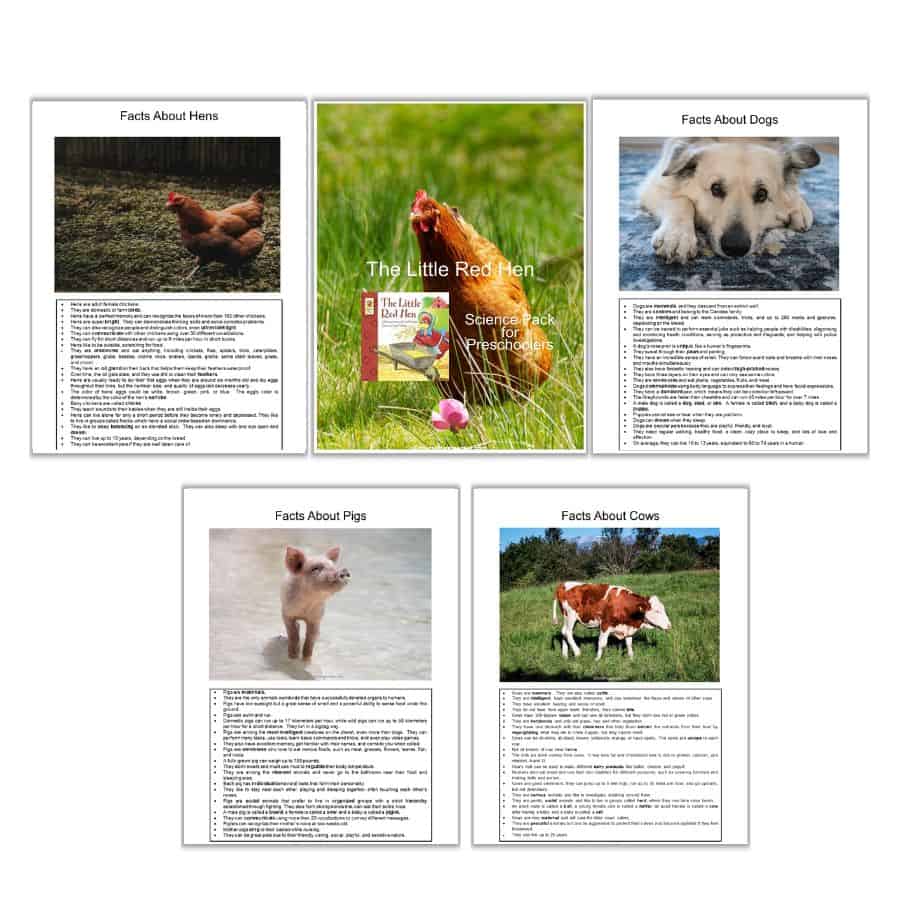
I also included cards to match their names in two versions, one with the names and another blank, to give you choices according to your children’s level. Print the cards and tags in The Little Red Hen pack on white cardstock and laminate them for durability. You can add Velcro to the tags if you want.
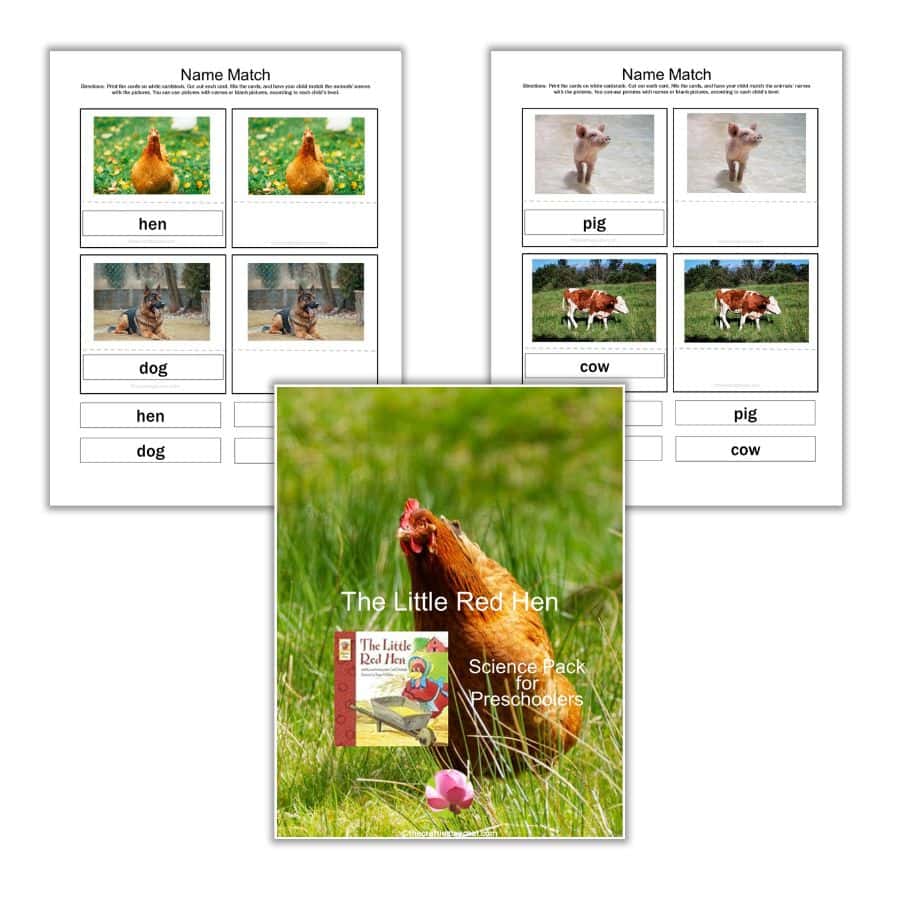
Matching The Little Red Hen Animals’ Body Parts
Preschoolers can learn about some animal body parts and their functions, which will help them see their differences and similarities. I’ve included two versions of each picture, one with names and another without. Select the ones that are more appropriate for each child, according to his or her developmental level.
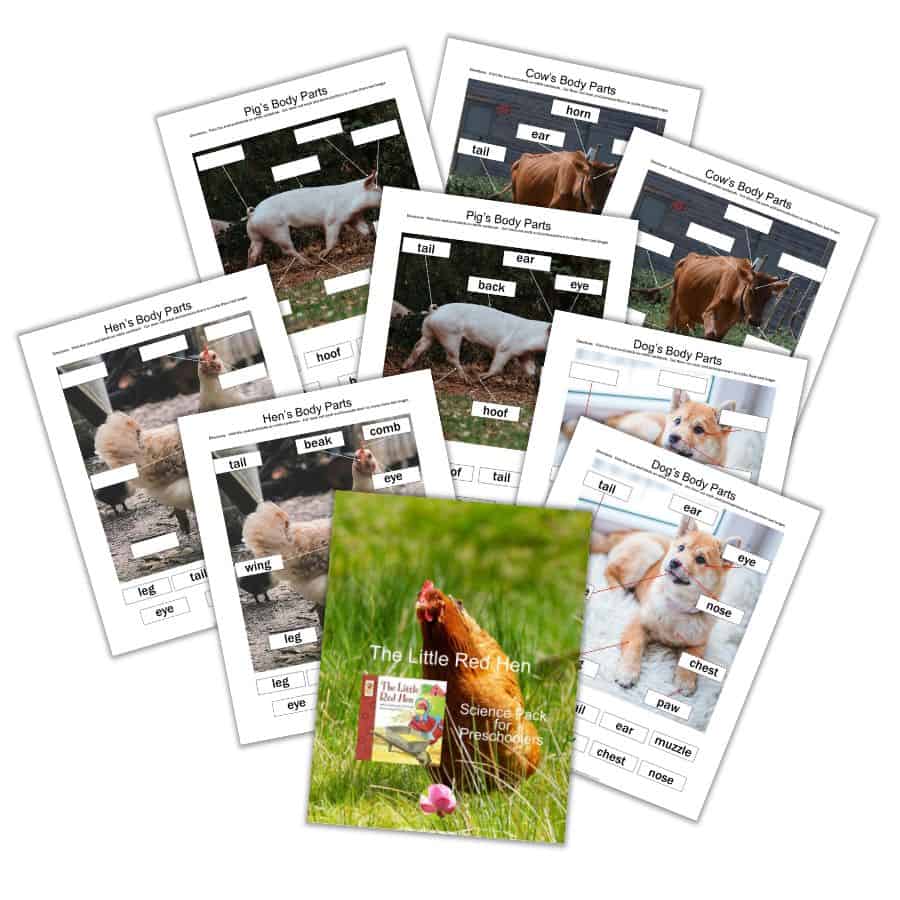
Print the pictures and tags in The Little Red Hen pack on white cardstock and laminate them for durability. You can add Velcro to the tags if you want. Teach the children the names of these animals’ body parts and what they are for, then invite them to practice matching the names of each animal’s body parts.
Observing and Planting Wheat Seeds
This powerful activity will teach your preschoolers more than pictures can. Place a paper towel with wheat seeds and magnifying glasses on the table. Invite them to observe the wheat seeds. Talk about where they come from, their characteristics, and how to plant them.
Explain that when seeds are planted, they need to receive sun and water. They then begin to germinate, which means they sprout, first growing a tiny root until they develop and become a plant. Show them the following videos so they can better understand the entire process.
After you explain and discuss the process, invite your children to plant wheat seeds so they can experience it firsthand. You will need wheat seeds, small pots, and soil to do this activity.
Explain that the wheat seeds they are looking at are dormant, meaning they are asleep or inactive. When seeds are planted and receive the correct amount of sun and water, they will wake up and begin germinating, which means they become active and sprout.
Explain to the students that they are going to germinate wheat seeds. Give each child a few wheat seeds, soil, and a pot with the child’s name. Have them place the soil in the pot, spread their wheat seeds on top, and complete with a light layer of soil.
Have them lightly wet the soil and place the pots outside where they will receive a lot of sun. Then, have them observe their pots daily to see if the wheat seeds have germinated.
During circle time, discuss what has been happening with the wheat seeds, if they have germinated, and the changes they have noticed. Review what the wheat seeds need to germinate (light and water). Ask the students if they think the baby plants (seedlings) have everything they need to continue to grow into healthy plants. Explain that plants need light, water, fertilizers (nutrients), and air to develop.
Making Bread
This is a fantastic activity to show your preschoolers the bread-making process.
Explain the differences between the two types of whole and refined grains. Explain that foods made with whole grains are darker and healthier and that refined grains are processed into flour so finely ground that they lose a lot of nutrients.
Present some examples of food made with both types of grains, such as brown rice, oatmeal, and whole wheat bread for whole grains and white bread, pasta, white flour tortillas, crackers, and cornflake cereal for refined grains.
Explain that planting wheat seeds, harvesting them, turning them into flour, and making bread takes a lot of time and hard work. Then, invite them to make bread together following this Wheat Kid-friendly Bread recipe from the allrecipes.com website.
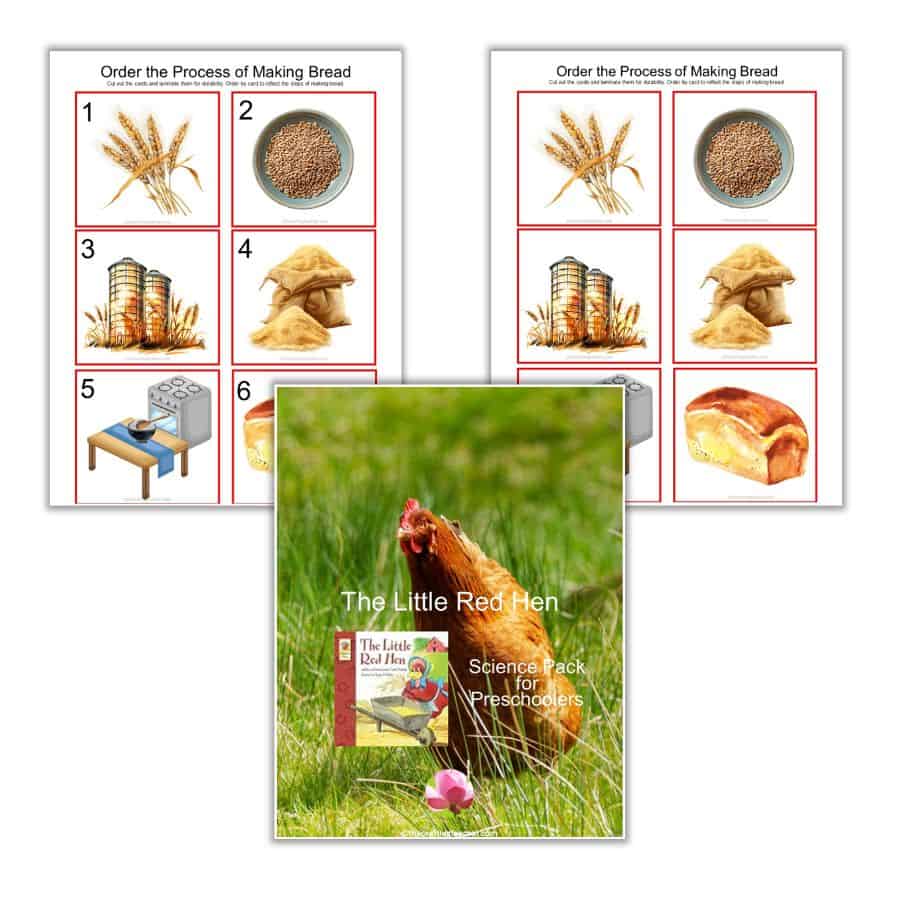
Another activity you can do is use the cards representing the process in The Little Red Hen Science Pack and invite your children to organize them in order. This pack comes with two sets, one with numbers 1 to 6 and the other without. Print them on white cardstock and laminate them for durability. Then, use the more appropriate set for your children’s developmental levels.
Other Activities
- Invite a farmer or gardener to come to the class and talk about planting and how to harvest.
- Invite your preschoolers to use seeds to make a collage.
- Use wheat stalks to paint instead of brushes.
- Ask your preschoolers to pretend they are germinating seeds and becoming little plants (seedlings) to the tune of instrumental music.
- Do this easy and fun bread Bread Science Experiment from the TotSchooling.net website.
Related Books
As usual, I like to include books in all my activities. These are some of the most exciting books you can find at your local library, used books store, and on Amazon. If you want fast access, click on the titles, and my links will take you directly to the book on Amazon.
- The Little Red Hen by Byron Barton.
- The Little Red Hen by Jerry Pinkey.
- The Little Red Hen by Paul Galdone.
- The Little Red Hen by Little Golden Books.
- The Hen Who Sailed Around the World: A True Story by Guirec Soudee
- Henrietta, the Hen Who Wouldn’t Come In by J B Allen.
- Hattie Peck by Emma Levey.
- What is Love, Mommy Hen? by Kate Kos.
- Chicken Coop Chaos by Nancy Tavares.
- Gwen the Rescue Hen by Leslie Crawford.
Pin It For Later
If you are in a rush and don’t have time to read the post and download the printable but want to save it, pin it to your science or another board on Pinterest for later.
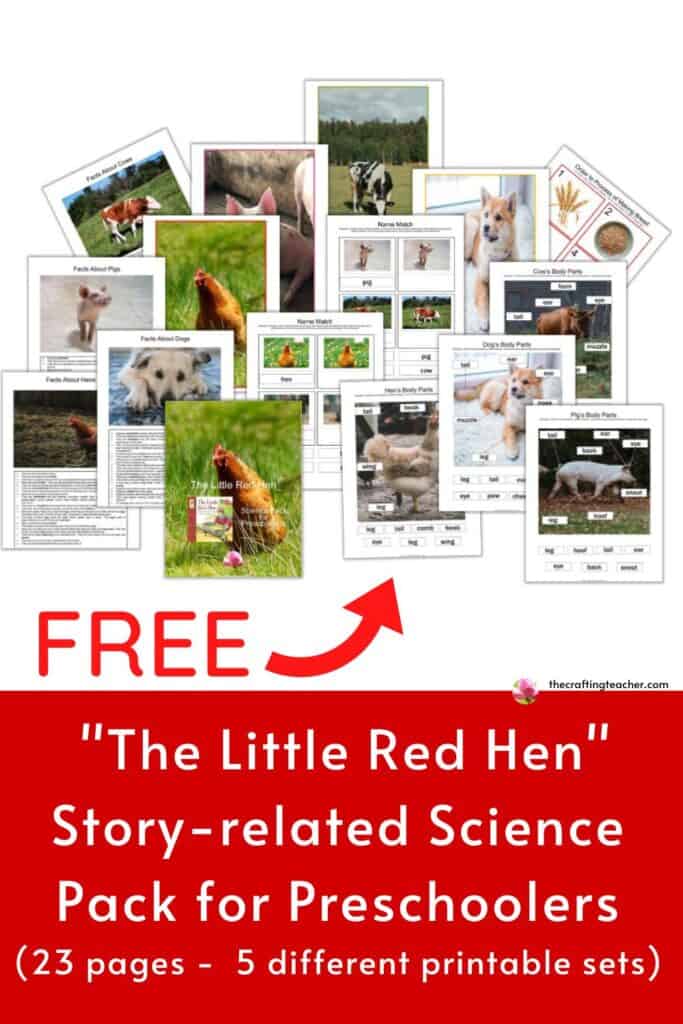
You can use these ideas by themselves, but I invite you to combine them with the activities I included in the literacy and math packs I created for this beautiful story, The Little Red Hen, to take advantage of the opportunity this book offers. Remember that you should not divorce literacy from math, science, or any other domain for a more comprehensive and complete educational process. They intermingle together and complement each other.
Remember to download your FREE The Little Red Hen Science pack. Click on the link below and type your email to get started.
Be happy, safe, and creative. I wish you well.
Love,

P.S. Let me know if these activities work for you, and if you want to see an article or a printable about making something specific, please let me know, and I will try to create it for you.

